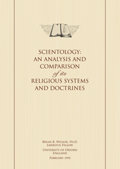IV.I. The Evolution of Religious Ideas
The case of Taoism illustrates the fact that religions do not arise fully-fledged as systems of belief, practice and organization. They undergo processes of evolution in all these respects, sometimes coming to embrace elements entirely at variance with earlier positions. For example, for decades some bishops of the Church of England have openly dissented from belief in such central tenets of the faith as the virgin birth, the resurrection of Jesus, and the second coming. Another such example is the changing conception of God as evident in the Judaeo-Christian scriptures, from the tribal deity of the ancient Israelites to a much more spiritually conceived and universal being in the writings of the later prophets and in the New Testament. Reconciliation of the divergent depictions of deity have given rise to disputes within and between churches and movements in Christianity, and the fundamental assumptions have steadily shifted over Christian history. Fundamental changes over the concept of the Christian God are occurring even today.
IV.II. Recent Theological Reappraisal of God
One such important current of thought which has profound implications for the status of Christianity, and which has some bearing on the matters at issue, is the widely canvassed refutation of the idea that there can be a supreme being of the kind traditionally acclaimed by the Christian Church. This current of opinion, promoted by some of the most distinguished theologians, comes, in particular, from the writings of Dietrich Bonhoeffer and Paul Tillich. For present purposes, it may be best exemplified from its most popular and influential expression. In 1963, the then (Anglican) Bishop of Woolwich, J.A.T. Robinson, summarized this current of theological thought in his bestselling book, Honest to God. The Bishop set out the arguments for the abandonment of the idea of God as a personal being who existed “out there” and challenged the whole idea of “Christian theism.”
IV.III. Evidence of Christian Atheism—Robinson
The following extracts make apparent the extent to which the Bishop and his associates departed from traditional assumptions respecting monotheism as entertained by both the laity and the law.
The Bishop cited Bonhoeffer in support of his arguments, as follows:
Man has learned to cope with all questions of importance without recourse to God as a working hypothesis. In questions concerning science, art, and even ethics, this has become an understood thing which one scarcely dares to tilt at any more. But for the last hundred years or so it has been increasingly true of religious questions also: it is becoming evident that everything gets along without ‘God’ just as before.
From Tillich, the Bishop cites the following:
…you must forget everything traditional that you have learned about God, perhaps even the word itself.
To which the Bishop adds:
When Tillich speaks of God ‘in depth’, he is not speaking of another Being at all. He is speaking of ‘the infinite and inexhaustible depth and ground of all being…’
For himself the Bishop says:
…as he (Tillich) says, theism as ordinarily understood ‘has made God a heavenly, completely perfect person who presides over the world and mankind’
The Bishop quotes the lay theological writer, John Wren-Lewis, approvingly:
It is not merely that the Old Man in the Sky is only a mythological symbol for the Infinite Mind behind the scenes, nor yet that this Being is benevolent rather than fearful: the truth is that this whole way of thinking is wrong, and if such a Being did exist, he would be the very devil.
Reinforcing this point, the Bishop says:
We shall eventually be no more able to convince men of the existence of a God ‘out there’ whom they must call in to order their lives than persuade them to take seriously the gods of Olympus.
Distinguishing, as theologians do, between reality and existence, the Bishop was asserting that God was ultimately real, but that he did not exist, since to exist was to be finite in space and time, t0 be part of the universe.
IV.IV. Evidence of Christian Atheism—van Buren
In the same year, 1963, Paul van Buren, an American theologian, wrote The Secular Meaning of the Gospel, which also canvassed Bonhoeffer’s concept of “religionless Christianity” i.e., that Christianity is not a religion. Even more strongly than Robinson, van Buren demanded that Christianity no longer be understood as in any sense committed to a belief in God. He proposed that all theological reference to God be eliminated. He held that “…simple literal theism is wrong, and qualified literal theism is meaningless”
IV.V. The Reappraisal of Jesus
Reinterpretation of the New Testament and of the person of Jesus had also been in progress in theological circles, certainly from the time of Albert Schweitzer, who, in 1906, published a work under the translated English title of The Quest of the Historical Jesus. Schweitzer revealed Jesus as a Jewish prophet with somewhat misguided ideas and very much a creature of his time. A more radical process of critical “demythologizing” was undertaken by Rudolf Bultmann, who, beginning in the 1940s, showed how fully the Gospels were subject to the myths prevailing at the time at which they were written. He went on to demonstrate how few of the concepts employed in the Gospels could be accepted by twentieth-century man. Bultmann himself sought to preserve a message for mankind from the New Testament very much in the terms of German existentialist philosophy. Christianity became a guide for the moral life of the individual, but it was no longer credible as a body of teaching about God’s creation and his governance of the world. The increasing effect of Bultmann’s work was to raise new doubts about the traditional claim that Jesus was God in the flesh. Doubt was now cast on the entire Christological teaching of the Church. The historical relativism of this approach found renewed expression in a work entitled The Myth of God Incarnate (edited by Professor John Hick), published in 1977, in which a number of the most distinguished of Anglican theologians disputed the traditional Chalcedonian view of the relationship of God to the man, Jesus. Modern theologians were finding it difficult to believe tl1at God had become man in the way in which Christian teaching had affirmed during the previous fifteen centuries.
IV.VI. Christianity Said Not to Be a Religion
These various currents of theological argument—the considered rejection of the concept of a personal God; the relinquishment of theism; the new emphasis on the relativism of the Bible; and the challenge to accepted concepts of the nature of Christ and his relation to the godhead—all amount to a severe departure from the received understanding of Christian faith. Christianity, for so long the implicit model in Europe for the conception of what a religion was expected to be like, was now declaring itself not to be a religion. In this way, the criteria by which religion had previously been defined was now brought into question.





























